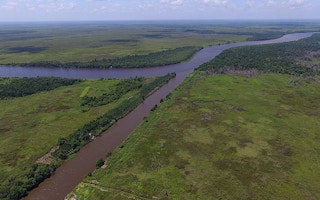Overexploitation of nature is putting our societies, economies and financial system on a path toward disaster – but we have a golden opportunity to help bend the curve of biodiversity loss downward at the Convention on Biological Diversity’s (CBD) 15th Conference of the Parties (COP15), in Kunming, China, where world leaders will agree on the future Post 2020 Global Biodiversity Framework (GBF) for the next ten years.
It is no exaggeration to describe COP15 as an event as of historical significance. Humanity has wiped out 83 per cent of wild mammals and half of all plants. Three-quarters of ice-free land and two-thirds of marine environments have been severely altered. The discussions at Kunming are as important to biodiversity as the Paris Agreement was to climate, and are likely to be similarly complex, if not more so. By extension, COP15 matters hugely to corporates and financial institutions around the globe, as tackling nature-related risks is set to become the new frontier for sustainable business and finance.
“
Solving the biodiversity crisis requires an overhaul of our economic system – and this demands that business is on board and ready to lead alongside governments.
Draft proposals are on the table that would set global goals and targets to take urgent action across society to put biodiversity on a path to recovery for the benefit of planet and people by 2030 and to live in harmony with nature by 2050. This would involve increasing conservation areas to cover 30 per cent of the world’s oceans and land by 2030, reduce threats to biodiversity, impose new controls on invasive species and reduce pollutions from all sources including plastic pollutions, increase contributions to climate changes mitigation and adaptation, amongst a host of other actions. If governments can agree to these goals and targets, our societies, economies and financial system may have a fighting chance at preventing the precipitous decline of the planet’s species and ecosystems.
But targets are only the starting point. Implementation, not ambition, is the true driver of success. It’s imperative that we back-up any agreed targets with specific implementation plans. Looking to the past at which environmental targets have succeeded and which have failed, we know goals need to be supported by clear next steps.
In 2010, countries united to create a 10-year plan, sub-divided into 20 targets, for protecting and conserving nature. The so-called Aichi Biodiversity Targets expired last year — and most of the targets were not reached. There are multiple reasons why the Aichi targets failed, but a critical problem was lack of coordination between governments, corporates and the finance sector, with limited action from the latter. Solving the biodiversity crisis requires an overhaul of our economic system – and this demands that business is on board and ready to lead alongside governments.
The stakes are even higher now, because scientists tell us this is the last decade we have to reverse nature loss and solve the climate crisis. To ensure that Kunming is a success, we’ll need to take a different approach this time. A lot is at stake, so it’s vital we bring all key actors to the table from the beginning.
That means working more closely with global business and financial sector, who have the power to direct financial flows away ecologically destructive operations. We have to treat business and financial sector as key drivers of solutions instead of seeing the private sector as a barrier to the sustainable use of natural resources.
Financial institutions and corporates have the necessary resources, autonomy, technology and ability to innovate. Since the world’s governments signed the Paris Agreement on Climate Change in 2015, climate action has become mainstream across business. Now, we need to enable the same step-change to happen for nature.
An increasing number of global businesses are leaning into efforts to protect nature, as they are realising the extensive financial risks posed by biodiversity loss. With over 50 per cent of the global economy highly dependent on nature, thriving biodiversity is a fundamental component of long-term business survival.
The loss of biodiversity can have a direct impact upon business operations, where raw materials are no longer available at the quality and quantity needed. Increasing costs in commodity supply chains, as a result of decreasing biodiversity, can have consequences on a company’s bottom line. Biodiversity-related risks hit across sectors and countries. Moreover, the nature and climate crises are inextricably intertwined: as 50 of the world’s leading scientists reminded us last month, we can’t solve one without solving the other.
The recent launch of the market-led Taskforce for Nature-related Financial Disclosures (TNFD) illustrates that the market is ready to move on nature-related risks and opportunities. This new global initiative – which is supported by a wide range of leading financial institutions and corporates, including AXA, BNP Paribas, Kering, KPMG, H&M and many more – aims to give businesses a complete picture of their environmental risks.
“
An increasing number of global businesses are leaning into efforts to protect nature, as they are realising the extensive financial risks posed by biodiversity loss. With over 50 per cent of the global economy highly dependent on nature, thriving biodiversity is a fundamental component of long-term business survival.
Having the private sector as the driving force behind the TNFD sends a strong message to global governments of the growing appetite from business and financial sector to halt and reverse nature loss. Knowing that the finance sector and corporates are onboard will help governments across the world agree on ambitious targets when they gather at COP15 later this year. Business action on biodiversity assures governments that taking urgent, ambitious action to halt and reverse nature loss is an economic and financial imperative.
To ensure close collaboration from an early stage of the process, last month the CBD hosted a virtual workshop with the leaders of major investors, insurance firms, public and private banks, governments and regulators, NGOs and academia and other institutions to gather their input on the draft post-2020 biodiversity framework for Kunming and key actions to implement the GBF.
Using the next three months to produce an ambitious yet actionable plan – supported by governments, financial institutions and corporates - is the challenge we now face. Corporates and financial institutions that engage in this process to set us up for success in Kunming - and in the decade of delivery that will follow - could find it to be the best investment they ever make.
Elizabeth Maruma Mrema, executive secretary of the United Nations Convention on Biological Diversity and co-chair of the Taskforce on Nature-related Financial Disclosures.


















